MANGROVE PRESERVATION AND URBAN AIR POLLUTION IN ARACAJU, NORTHEAST BRAZIL
DOI:
https://doi.org/10.12957/geouerj.2024.71735Palavras-chave:
Urban trees, Urban Climate, Sergipe, Ecosystem services, Mobile air pollution measurementsResumo
According to WHO, in 2010 the air pollution was the main cause of over 200 thousand obits related to lung cancer. This paper aims to analyze the role of mangrove and their preservation on air pollution mitigation at Aracaju, northeast Brazil. The city was founded by the Sergipe River, few kilometers from the Atlantic Ocean, which configures it as an ideal site for mangrove development. Mobile measurements of CO were taken place in an urbanized area close to a mangrove area, providing an idea of the pollutant spatial dynamics. The benefits of the mangrove preservation were calculated using the ITree canopy v.7.1. The results reveal that the Mangrove preservation is responsible for over 4 tons of pollutants removal per year, a fact that can be related to the low levels of pollutions registered on the area during the measurements, helping to endorse the urban trees and mangrove areas preservation.
Downloads
Downloads
Publicado
Como Citar
Edição
Seção
Licença
Copyright (c) 2024 Francisco Jablinski Castelhano, Josefa Eliane Santana Pinto

Este trabalho está licenciado sob uma licença Creative Commons Attribution-NonCommercial-ShareAlike 4.0 International License.
Os Direitos Autorais dos artigos publicados na Revista Geo UERJ pertencem aos seus respectivos autores, com os direitos de primeira publicação cedidos à Revista. Toda vez que um artigo for citado, replicado em repositórios institucionais e/ou páginas pessoais ou profissionais, deve-se apresentar um link para o artigo disponível no site da Geo UERJ.

Os trabalhos publicados estão simultaneamente licenciados com uma Licença Commons BY-NC-SA 4.0.


